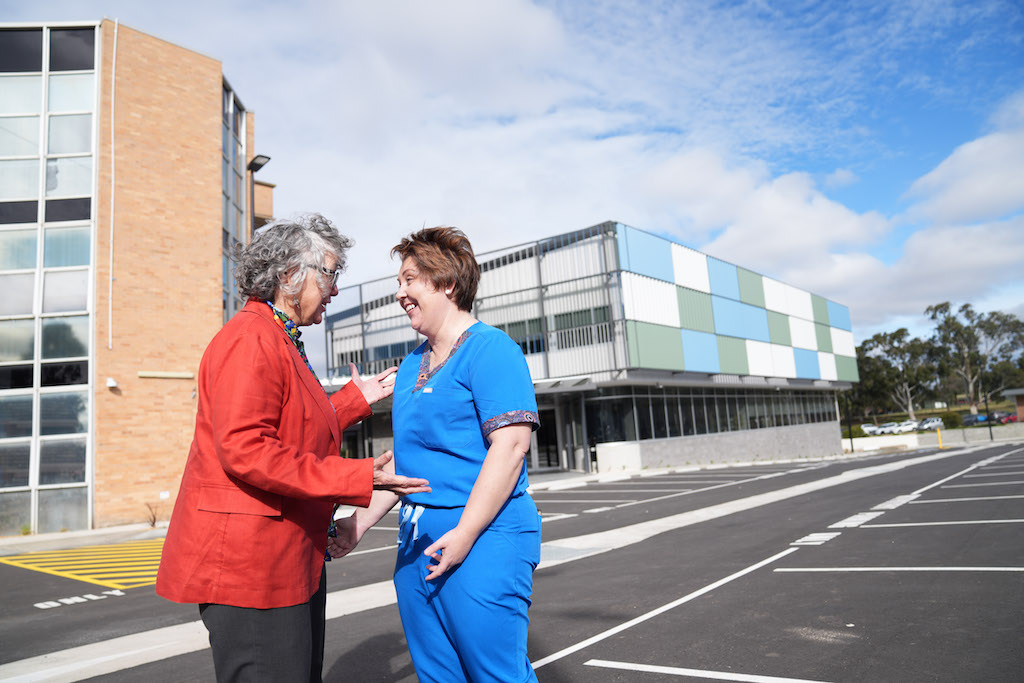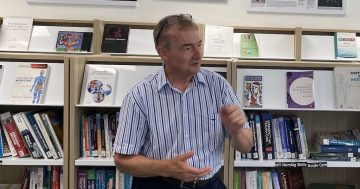
Former Head of the ANU Rural Clinical School Amanda Barnard with fourth-year medical student Natalie Gordon of Goulburn, outside the Amanda Barnard Clinical Training Facility at Goulburn Base Hospital. Photo: Tracey Nearmy (ANU).
Teaching health professionals in Goulburn have taken a step forward with the opening on Tuesday of an $11 million clinical training facility at the Goulburn Base Hospital.
The new building will accommodate a high-fidelity clinical simulation lab where teaching staff and students do simulated health education using highly elaborate, technologically advanced manikins.
Head of the ANU Rural Clinical School, Professor Sally Hall Dykgraaf said the new training building would also have clinical teaching rooms, an auditorium, meeting rooms, common areas for staff and students and a clinical library.
“This building will function in a collaborative way with the hospital,” Professor Hall Dykgraaf said. “It is already being used not just to train our medical students but for all kinds of health professional education and training that is run by the hospital and by the local health district. They get to use the building as well and we occupy it in partnership.”

Former Head of the ANU Rural Clinical School Amanda Barnard with the Member for Macarthur Dr Mike Freelander and third-year medical student Samuel Walterlin in a high-fidelity simulation lab in the Amanda Barnard Clinical Training Facility at Goulburn Base Hospital. Photo: Tracey Nearmy (ANU).
The ANU has been running medical education in Goulburn since 2006 as part of the ANU School of Medicine and Psychology (previously known as the ANU Medical School).
One of the current trainee doctors is Natalie Gordon, daughter of Michael and Jennie Gordon of Goulburn and a teacher for 18 years.
Goulburn is one of six regional areas to have a rural training clinic run by the ANU. The others are at Moruya – serving the Eurobodalla local government area – Cooma, Bega, Cowra and Young.
Previously in Goulburn, staff at the clinic operated from a demountable on the Base Hospital site.
“This building is about giving us the physical home that we haven’t had up until now,” Professor Hall Dykgraaf said.
The school trains doctors throughout the region, and has 30 medical students in Goulburn all year from February to November doing all of their medical teaching and training in the local community and the same in the other five communities.
“We are hopeful that over time other universities who are training other health professional disciplines might also start to work with us in using the building, for example the University of Canberra who train nursing and allied health professionals here,” Professor Hall Dykgraaf said.
“We are also hopeful that other members of the community who are interested in doing forms of education or health related meetings or activities might also want to use the building, and so it will be available for use by community members as well.”
Funding came from the Australian Government’s overall grant of $15 million, made under the Rural and Remote Health Infrastructure Project to provide teaching facilities plus some clinical consulting facilities and student accommodation.
Open from 8 am to 5 pm, the new facility has been named the Amanda Barnard Building, in recognition of Professor Amanda Barnard, founding head of the Rural Clinical School and Associate Dean of Rural and Indigenous Health at the ANU.










